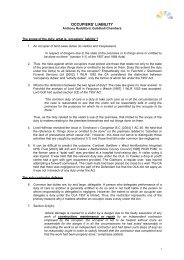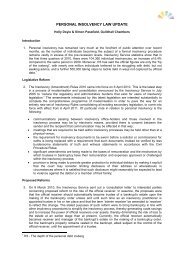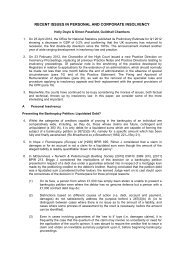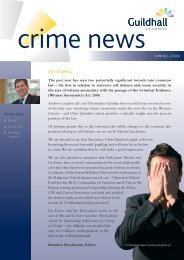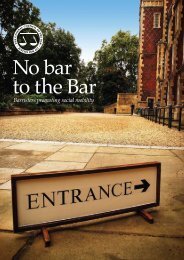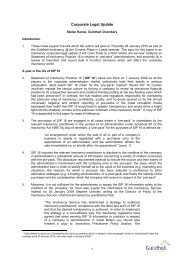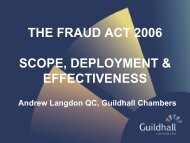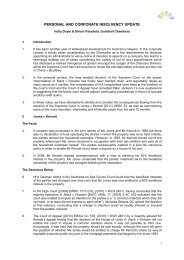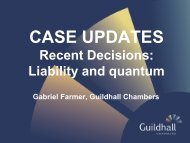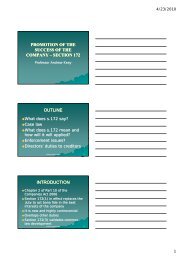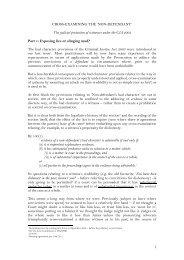Adam Chippindall, Gabriel Farmer & Sophie Holme - November 2010
Adam Chippindall, Gabriel Farmer & Sophie Holme - November 2010
Adam Chippindall, Gabriel Farmer & Sophie Holme - November 2010
Create successful ePaper yourself
Turn your PDF publications into a flip-book with our unique Google optimized e-Paper software.
Guildhall Chambers Personal Injuries Claimant Seminar11 th <strong>November</strong> <strong>2010</strong>MAKING MULTIPLIERS WORK FOR YOUR CLIENTWORKSHOP ANSWERS<strong>Adam</strong> <strong>Chippindall</strong>, <strong>Gabriel</strong> <strong>Farmer</strong> and <strong>Sophie</strong> <strong>Holme</strong>, Guildhall ChambersBASIC USE OF MULTIPLIERSC was born on the 1 st June 1975. He was injured on the 1 st December 2009. The trial is on 1 stDecember <strong>2010</strong>.He can work still as a brick layer but now he is part-time. The medical reports agree that he will not beable to work beyond 55.One of his injuries was to his right ankle and the experts have agreed that he will need orthotics, forlife which will cost him about £75 each year and he will also need to visit the specialist for remeasurementevery 3 years for the next 30 years at a cost of £100 per visit.He would have retired at 65.For these purposes ignore “contingencies other than mortality”.1. Which of the Ogden Tables would you use to find the appropriate multipliers?[Because you are dealing with a future loss, always advise your client about PeriodicalPayment Orders]C will be 35½ at trial so interpolation between ages 35 and 36 is required. The rate of return isset at 2.5%.Table 1 – Loss for life: [27.5 +27.18] ÷2 = 27.34Table 5 – Earnings to age 55: [15.53+14.92] ÷2 = 15.225Table 9 – Earnings to age 65: [20.53+20.05] ÷2 = 20.29Table 21 – Loss of pension from age 65: [6.98+7.13] ÷2 = 7.055Table 28 – Term certain: 30 years = 21.19NB, given retirement would have been at 66 it is necessary to interpolate between tables,hence use of two tables is required for earnings and pension – see below.2. What multiplier do you arrive at for his loss of earnings claim?Loss of earnings from 35½ to 65 = [20.53+20.05] ÷2 = 20.29Loss of earnings from 35½ to 55 = [15.53+14.92] ÷2 = 15.2253. What multiplier do you arrive at for his cost of orthotics claim?Loss for life [27.5 +27.18] ÷2 = 27.341
4. What multiplier do you arrive at for his cost of measurement claim?(a) [simple calculation]Work out “annual” cost i.e. ⅓ x £100 per annum for measurement. Then simply applyTable 28 to the term of 30 years as above.£33.33 x 21.19 = £706.26(b) [periodic multiplier – Table A5]n = 30 years, 2.5% table, frequency =3Multiplier = 6.81£100 x 6.81 = £681Observations:(i)Method (a) is:simpler and gives a higher figure!routinely accepted in equipment claims;uses a multiplier (as opposed to a fixed number of years) so is amenable forlife calculations or calculations to a particular age where the table easilyproduce a multiplier.(ii)Method (b) is:more accurate;and therefore more appropriate in higher value claims; andcomplex if not based on fixed years but a multiplier where mortality needs tobe accounted for (see paras 9 and 10 of the notes to Table A5).(iii)In particularly high value cases (falling short of PPO) the discount for acceleratedreceipt for each individual payment would be calculated separately in order toaccount for (a) the time in the year when the payment would be made and (b) deathfalling between payments at the end of life.5. How do you calculate the multiplier for his loss of pension?(a) Work out the reduced amount of his net annual pension loss from age 65 (e.g. £5000p.a.).(b) Use the multiplier from Table 21 as above. 7.055 x £5000 = £35,275.Observations:(i) What if the retirement age was 66?See paras 13 & 14 of the Notes to the Ogden Tables: interpolation isrequired. The calculation is complicated but simply work through the steps inthe guidance.1. R = 66; A = 65; B = 702. A = (35.5 + 65 - 66) = 34.53. M = (34.5 from T21 = 6.98 + 6.83 ÷2 = 6.904. B = (35.5 + 70- 66) = 39.55. N = 39.5 from T23 = 5.59 + 5.47 ÷2 = 5.536. (70 – 66) x 6.9 + (66 - 65) x 5.53 ÷ [(70 - 66) + (66 - 65)] = 6.632
Simple, but less accurate alternative: take the interpolative figures fromTables 21 & 23 (i.e. 7.05 & 5.09). The difference is 1.96 which is an annualfigure of 0.39; subtract that from the lower, Table 21 figure - 7.05 - 0.39 =6.66.Now assume that his right ankle injury was much more serious, so that he is unable to walkvery far without having to rest; he cannot stand for long periods (more than 15 minutes) and isin pain. He is about to undergo an arthodesis, which will fuse his ankle and mean that he canwalk almost normally, and stand without pain.6. How do you assess the discount for “contingencies other than mortality”?(a) Look up (paras 35 et seq. Notes to the Ogden Tables) the following:Employment status: employed or not employed;(here C was and will be employed)Disability status: disabled/not disabled;(here C was not disabled but now is disabled)Educational attainment.(here assume “O”)(b) In calculating lost earnings it is necessary to calculate (i) what C would have earned andthen deduct (ii) what he will earn.(c) So, in assessing what he would have earned use table A, 35-39, O, employed = 0.89.(d) And in assessing what he will now earn,use table B, 35-39, O, employed = 0.39.(e) The calculation incorporating contingencies other than mortality is therefore as follows:Would have earned (say) £20,000 x 20.29 x 0.89 = £361,162 LESSWill earn (say) £10,000 x 15.225 x 0.39 = £59,377 = £301,785However, now assume that just before trial evidence emerges that there is a 75% chance thathe will be made redundant in the year after the trial. Assume that the Defendant agrees that hequalifies for a “Smith v Manchester” payment to cover this risk.7. Can the Ogden Tables assist with assessing such an award, and if so how?The Claimant’s residual earning capacity was £10,000 x 15.225 x 0.39 = £59,377. However, if theClaimant was out of work at trial his “contingencies other than mortality” would have been calculatedunder table B as 35-39, O, Not employed = 0.2 thereby producing £10,000 x 15.225 x 0.2 = £30,340some £28,927 less. So, if the differential between “employed” and “not employed” is £28,927 you canargue that C should qualify for 75% of this differential in order to compensate him for the risk ofredundancy. 75% x £28,927 = £21,695.Now assume that C died in the accident and the claim is being brought by his widow (aged 30at his death). The post mortem revealed that C was otherwise healthy.There are 2 children aged 6 and 3 at his death.The widow did not work.8. How do you calculate the multiplier for:3
a) loss of financial dependency (we will ignore “contingencies other thanmortality”).;b) loss of services dependency (assuming he did nothing for his wife)?Multipliers under the FAA 1976 must be calculated from the date of death (Cookson v Knowles [1976]AC 556) rather than from the date of trial. C was 34.5 at his death.a) Consider the age of the relevant dependant. This is because the dependency willonly last for the lesser of the two periods: from death to when the deceasedwould have provided the dependency; from death to when the dependant wouldhave been in receipt of that dependency. e.g. if the only dependant was a Widowaged 50 then the multiplier for the deceased (@ 0%) would be 49.31, for thewidow would be 36.69 - therefore the dependency would only last for her lifetime.In our scenario the crucial multiplier is that of the deceased. Because there is apension the multiplier will last for his lifetime. Facts & Figures can be confusing.There are Life Tables based on historic data, a Life Table based on projectedmortality, and Tables 1 & 2 include mortality rates for the UK (i.e. including theless favourable mortality of the Scots and Northern Irish).Historic Table = 44.24 years (A3 - 44.72 + 43.77 ÷ 2).“Expectation of Life Table” (next page in F&F) = 51.45.T1 (@0% Male) = 49.31.If use “life expectation” figure (51.45) then must apply Table 28 to that figure, totake into account the so-called discount rate (for “accelerated receipt”) of 2.5% =29.36. NB. This figure does not include the risk of mortality between death andactual death and death but for the accident; it assumes survival to age 85. 95(34.5 + 51.45). Cf. with Table 1 @ 2.5% for a 34.5 year old which is 27.67 where“mortality - the risk of death - has been included.The fun bit is in dividing it up into the various segments (because thedependency changes):1. death to trial, which effectively is treated as “past loss”;2. from trial to the date when the youngest child ceases being dependant(perhaps 16; 18; or after University; or 21?). If we assume to age 21 thatwould have been a period of 17 years (21 - 4).3. from that date to his expected retirement at age 66 which would havebeen 31.5 (66 - 34.5)4. from that date to his expected death, but for the accident.We need to take the chronological time and covert that into a multiplier; so, thetotal period is 51.45 years.No. of years T281. 1 0.992. 17 (18 - a) 13.42 - 0.99 = 12.433. 13.5 (31.5 - b) 21.89 - 13.42 = 8.474. 19.95 (51.45 - c) 29.13 - 21.66 = 7.4729.364
) His services for his children would have stopped when they reached 21.Assume, for the sake of argument, that he provided an average of £100 whenthere were two children at home and an average of £50 for the remaining child.From death the period certain is 15 years for the older child and 17 years for the younger. The totalmultiplier from T 28 is 13.88. Of the 17 years 15 would have been at £100, which is 88% of the time.13.88 x 88% = 12.21 can be ascribed to the £100 and 1.67 to the £50.5
Employment statusWhat if my client is a woman in her 20’s and the Defendant says “you must make a discount to reflect“the child –rearing years”?A v Powys Local Health Board [2007] EWHC 2996What about females and time off for children? – See para 41 Ogden Guidance. No discount.What if my client is now not employed but “should be in employment”?Hunter v MOD [2007] NIQB 43Dispute over residual earning capacity. C disabled and unemployed. Therefore Table Bdiscount 0.2. If employed discount would have been 0.49. Judge hold “C should be inemployment by now” and appropriate discount multiplier is 0.4!Leesmith v Evans [2008] EWHC 134Employment consultants agreed that injured C had average residual earning capacity of£10,000 pa. D seeks to apply table A discount (not disabled) of 0.82 (the disabled discountbeing 0.54) because the multiplicand already accounted for disability. Judge agrees “in part”and reduces discount to 0.60. NB average earnings avoided Blamire award.What if at the accident my client was employed but historically his employment record was poor?Huntley v Simmonds [2009] EWHC 405C a bad boy – drugs, alcohol but sporadically employed as ground worker. Employed at timeof accident. Employed discount 0.89, unemployed discount 0.82. Underhill J awardsunemployed discount taking into account all factors.Peters v East Midland SHA [2008] EWHC 778The LA accommodation funding case. Appropriate discount 0.68. Butterfeild J increaseddiscount to 0.6 pre-trial and 0.5 post trial as C’s family background suggested a culture ofbenefit reliance and incentive to find and keep work not strong. Argument for lower discountswhere C from hard-working family?… or his employment record was very good…?Hopkinson v MOD [2008] EWHC 699Micheal Harvey QC reduced pre-injury discount from 0.81 to 0.9 on the basis that C had beenconsistently in work throughout his career.Ogden 6: the magic bullet – is Blamire dead?Van Wees v Karkour [2007] EWHC 165The dreaded Blamire award. However, £850,000 awarded.Bullock v Atlas Ward Structures Ltd [2008] EWCA 194“Merely because there are uncertainties about the future does not in itself justify a departurefrom that well-established method. Judges should therefore be slow to resort to the broadbrushBlamire approach, unless they really have no alternative”I have a Judge who is happy to tinker with discounts: how do I rein him in?Visual analogue scale of discounts7
Handy articles:A Quantum Update: Pushing Boundaries [2009] JPIL 140.Ogden Six – Adjustments to Working Life Multipliers [[2009] JPIL 66.Serious Personal Injury Litigation – A quantum update [2008] JPIL 109.Discretion in the application of the new Odgen Six Multipliers [2008] JPIL 154.<strong>Adam</strong> <strong>Chippindall</strong><strong>Gabriel</strong> <strong>Farmer</strong><strong>Sophie</strong> <strong>Holme</strong>Guildhall Chambers<strong>November</strong> <strong>2010</strong>8




